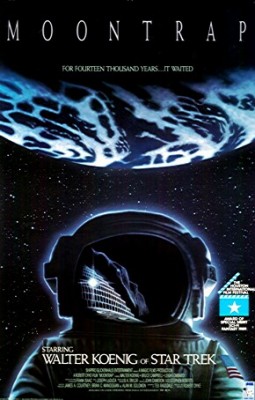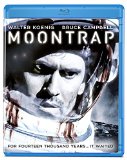| Reviews & Columns |
|
Reviews DVD TV on DVD Blu-ray 4K UHD International DVDs In Theaters Reviews by Studio Video Games Features Collector Series DVDs Easter Egg Database Interviews DVD Talk Radio Feature Articles Columns Anime Talk DVD Savant Horror DVDs The M.O.D. Squad Art House HD Talk Silent DVD
|
DVD Talk Forum |
|
|
| Resources |
|
DVD Price Search Customer Service #'s RCE Info Links |
|
Columns
|
|
|
Moontrap
Exactly how much money and under what conditions they had to work with is hard to say. I watched the Blu-ray's accompanying interviews with stars Walter Koenig and Bruce Campbell, but only sampled its audio commentary with Dyke and Ragsdale. A review of the disc over at Blu-ray.com is extremely harsh on the video transfer and audio, but I suspect at least part of the reason the movie looks so soft and drab on disc (though not to the extent Blu-ray.com's reviewer claims it is) could be explained were Moontrap's 1st unit scenes (as opposed to SPFX footage) shot in 16mm and blown-up to 35mm, especially if the HD transfer was derived from 35mm pre-print material. Production notes cite a "multi-million dollar" budget, but that may well be hype. At a guess I'd say Moontrap looks like it may have cost around $500,000, perhaps even a bit less than that, but it's certainly cheap even when compared to Roger Corman's threadbare New World/New Concorde sci-fi thrillers of that same era.
The story superficially resembles Tobe Hooper's Lifeforce (1985), which in turn owed much to Nigel Kneale's "Quatermass" TV dramas and films. There are even touches of H. Rider Haggard's She. Moontrap opens with good use of stock footage of the Apollo 11 moon landing in July 1969. In the film, a robotic eye closely monitors the earthly visitors' movements.
Later, apparently in the early 1990s, the Space Shuttle Camelot is orbiting the earth. Mission Commander Col. Jason Grant (Star Trek's Chekov, Walter Koenig) and co-pilot Ray Tanner (The Evil Dead's Bruce Campbell), encounter a derelict alien spacecraft. Grant leaves the shuttle and brings back a mummified, 14,000-year-old humanoid corpse and an egg-like pod that looks like a cross between a football and a watermelon. Both apparently originate from earth's moon.
As Grant and Tanner argue with government officials over NASA funding, the pod comes to life, somewhat inexplicably building itself into an enormous cybernetic killing machine incorporating body parts from the mummy. There's a big gun battle before the cyborg is destroyed. Grant and Tanner are sent on an emergency mission to the moon to investigate.
Considering that it was Ragsdale's and Dyke's first feature as screenwriter and director, Moontrap is admirably confident and polished. While not especially original, the screenplay has its share of surprises. Though The Terminator, with its similarly unstoppable extermination machines, had made a big splash a few years before, Moontrap's menace, artificial intelligence with both machine and human components, was something new in film. They're quite similar to the Borg, villains that debuted in a May 1989 episode of Star Trek: The Next Generation, literally days after Moontrap's 28 April premiere at WorldFest Houston.
At 96 minutes, Moontrap is well paced and intelligent throughout. Some effort has been made to flesh out its two main characters, though the script might have gone even further with this. For instance, Jason Grant is a veteran astronaut who never made it to the moon during the Apollo program, while Ray Tanner, though considerably younger, is by NASA's high standards also past his prime. Grant is apparently a widower and single father. When, on the moon, the two astronauts find a beautiful humanoid woman (Leigh Lombardi) held for thousands of years in suspended animation, it's Grant, rather than the younger Tanner, who is attracted to her.
This leads to an unexpected love scene, the intent of which may have been to simply to ensure an "R" rating and make the film more exploitable (there is one other instance of fleeting gratuitous nudity, early in the picture), but the sequence is nonetheless staged in a manner that looks nothing at all like the usual cheap exploitation picture, but rather similar to the love scenes in Tarkovsky's Solaris (1972). If you're gonna steal, steal from the best.
There are other nice little touches and attention to detail throughout, as well as effective moments of intentional humor. The lighting and camerawork of the long scenes on the moon's surface are exceptionally well done, far superior to many bigger-budgeted films (Superman II immediately comes to mind). A shootout on the moon's surface smartly avoids sounds in vacuum-less space, and the astronauts have stubbly beards, an acknowledgement of the several days of flight from the earth to the moon. Also commendably, Ragsdale script leaves some questions unanswered, to good effect.
The film has far more special effects shots than most films of its budget level, and most of these are adequate-to-excellent, especially considering that they were apparently done entirely independently, in Michigan, by effects houses that surely hadn't had much experience in feature film work. Most of the pre-CGI era effects appear to involve conventional miniatures photographed using motion-control technology, but there's much obvious effort to combine the live actors into shots wherever possible. Many of these shots, apparently, cleverly utilize forced-perspective.
Though some of the presumably local talent deliver shaky, almost amateurish performances, Koenig and Campbell are both more than capable. Koenig, of course, had toiled away on Star Trek for years, initially on the second and third seasons of the original series, then again on the later feature film series. Unquestionably the thought of playing the leading character appealed to him; he has more to do in this film than in all of the Star Trek movies combined. Viewers expecting Campbell's character to become the focus of the script's second-half are in for a surprise.
Video & Audio
Olive Films' Blu-ray of Moontrap's 1.78:1 HD presentation isn't likely to win any awards, though it's not the total disaster Blu-ray.com's reviewer seems to think it is. The image is soft and flat, though hardly on the level of a VHS tape, which their reviewer implies. It should definitely look better than it does, but there may be extenuating circumstances like those described above. They were equally disappointed with the 2.0 DTS-HD Master Audio, but many of these complaints seem inherent less to the new mix than the original mono tracks. No alternate audio options or subtitles.
Extra Features
Supplements include two amateurishly shot interviews, one with Koenig and the other with Campbell, running 33 and 21 minutes, respectively. Both seem to have been shot in the storage room of a local Texaco gas station. The audio is terrible to begin with, compounded by what sounds like an unsecured mike and much page-rustling on the part of its unidentified interviewer. The interviewer asks them the same identical, inane questions - he's like a cub reporter from a local high school - while at the same time straining to appear hip and "above" the assignment. (He goes out of his way to tell Koenig that he's not a Star Trek fan, though some of his friends are.) At one point he attempts, badly, a joke at Koenig's expense, getting an important point completely wrong along the way; it's amazing whoever produced this didn't have the decency to take it out. The questions clearly try actor Koenig's patience though he struggles through it gamely enough. Somewhat better is the audio commentary with Dyke and Ragsdale, which this reviewer only had the chance to briefly sample.
Parting Thoughts
The video transfer isn't at all impressive and the movie is no lost classic, but Moontrap is nonetheless strangely appealing. It's clearly aiming for the stars and in some ways succeeds. Such films are hard to dislike and for this reason the Blu-ray is Recommended.
Stuart Galbraith IV is the Kyoto-based film historian and publisher-editor of World Cinema Paradise. His credits include film history books, DVD and Blu-ray audio commentaries and special features.
|
| Popular Reviews |
| Sponsored Links |
|
|
| Sponsored Links |
|
|
| Release List | Reviews | Shop | Newsletter | Forum | DVD Giveaways | Blu-Ray | Advertise |
|
Copyright 2024 DVDTalk.com All Rights Reserved. Legal Info, Privacy Policy, Terms of Use,
Manage Preferences,
Your Privacy Choices | |||||||














